Bulgarian Black Sea Coast
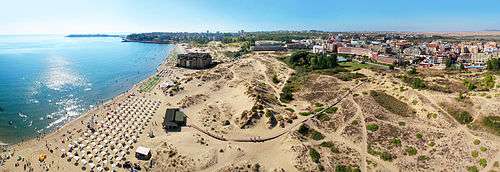

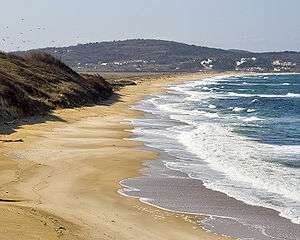
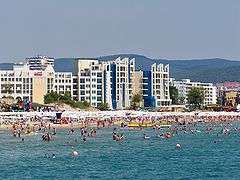

The Bulgarian Black Sea Coast (Bulgarian: Черноморие, Chеrnomoriе) covers the entire eastern bound of Bulgaria stretching from the Romanian Black Sea resorts in the north to European Turkey in the south, along 378 km of coastline. White and golden sandy beaches occupy approximately 130 km of the 378 km long coast. The region is an important center of tourism during the summer season (May–October), drawing millions of foreign and local tourists alike and constituting one of the country's most popular tourist destinations. Prior to 1989 the Bulgarian Black Sea coast was internationally known as the Red Riviera. Since the fall of the Iron Curtain, however, its nickname has been changed to the Bulgarian Riviera.
The Bulgarian Black Sea Coast has a humid subtropical climate (Köppen climate classification Cfa), with considerable maritime and continental influences. The area's average air temperature in the summer is about 28 °C, with the average water temperature at 26 °C. There are more than 240 hours of sunshine in May and September and more than 300 hours in July and August.
The Balkan Mountains cross the country reaching to the edge of the Black Sea at Cape Emine, dividing the coastline into a southern and northern part. Parts of Bulgaria's northern Black Sea Coast feature rocky headlands where the sea abuts cliffs up to 70 metres in height. The southern coast is known for its wide sandy beaches. The southernmost section is included in Strandzha Nature Park.
The two largest cities and main seaports on the Bulgarian Riviera are Varna (third largest in the country) and Burgas (fourth largest in the country). Varna is located on the northern part of the coast and Burgas is located on the southern coast. The two cities' international airports, Varna Airport and Burgas Airport, are the main hubs servicing the region. In addition, the Trakia motorway (A1) was completed in 2013, providing fast access between Burgas and Sofia, the capital of Bulgaria, and Plovdiv, the second largest city. Hemus motorway (A2), scheduled to be completed after 2020, would make the trip from Sofia to Varna substantially easier and faster, while the Cherno More motorway (A5) is planned to connect Varna and Burgas. Major road I-9 runs along the Black Sea coast between the border with Romania, at the village of Durankulak, and the city of Burgas.
Principal towns
Major resorts and attractions
- Durankulak
- Krapets
- Shabla
- Tyulenovo
- Kamen Bryag
- Yaylata
- Rusalka
- Balgarevo
- Kavarna
- Bozhurets
- Beglik Tash
- Topola
- Tuzlata
- Albena
- Kranevo
- Golden Sands
- Golden Sands Nature Park
- Holiday Club Riviera
- Chaika
- Sunny Day (Kokodiva)
- Constantine and Helena
- Galata
- Fichoza
- Kamchia (resort)
- Kamchia (biosphere reserve)
- Shkorpilovtsi
- Karadere
- Byala
- Obzor
- Irakli
- Elenite
- Sveti Vlas
- Sunny Beach
- Ravda
- Pomorie
- Sarafovo
- Atia
- Chernomorets
- Kavatsite
- Dyuni
- Primorsko
- Kiten
- Lozenets
- Tsarevo
- Strandzha Nature Park
- Varvara
- Sinemorets
- Rezovo
Historic sites
Islands
Rivers
- Aheloy
- Batova
- Dvoynitsa
- Fakiyska
- Hadzhiyska
- Kamchiya
- Provadiya
- Rezovska
- Ropotamo
- Shkorpilovska
- Veleka
World War II
| Bulgarian Coastal Campaign | |||||||
|---|---|---|---|---|---|---|---|
| Part of Black Sea campaigns (1941-44) | |||||||
Bulgarian troops aboard torpedo boat Drazki | |||||||
| |||||||
| Belligerents | |||||||
|
|
| ||||||
| Casualties and losses | |||||||
|
Bulgaria: 1 torpedo boat sunk 1 steamer sunk Romania: 1 auxiliary minelayer sunk Italy: 1 tanker sunk Turkey: 1 passenger ship sunk 3 sailing ships sunk |
5 submarines sunk 1 submarine heavily damaged | ||||||
The Bulgarian Coastal Campaign of World War II consisted in Axis and Soviet naval operations along the Bulgarian coast.
The Bulgarian Navy during World War II supported the Axis Powers in the Black Sea and consisted mainly of four obsolete Drazki-class torpedo boats, five modern Lurrsen type motor torpedo boats and three formerly Dutch motor torpedo boats. Bulgaria saw little naval fighting during the war, its main action taking place in October 1941.[1]
The so-called Operation Varna consisted in the minelaying of the Bulgarian coast by the Romanian minelayers Amiral Murgescu, Regele Carol I and Dacia, escorted by Romanian 250t-class torpedo boats Năluca, Sborul and Smeul, Romanian gunboats Sublocotenent Ghiculescu and Căpitan Dumitrescu and Bulgarian torpedo boats Drazki, Smeli and Hrabri.[2] The operation, lasting between 7 and 16 October 1941, was largely successful, as despite the loss of the Romanian auxiliary minelayer Regele Carol I to a Soviet mine,[3] the five minefields laid by the Romanian minelayers along the Bulgarian coast are credited with the sinking of four Soviet submarines: S-34, L-24, Shch-211 and Shch-210, although the latter could have also been sunk by German aircraft or depth-charged by the Bulgarian patrol boats Belomorets and Chernomorets.[4] Romanian mines also heavily damaged the submarine Shch-205 off Varna on 4 December 1941.[5]
On 6 December 1941, Belomorets and Chernomorets depth-charged and sank the Soviet submarine Shch-204.[6]
Soviet submarines also laid mines near the Bulgarian coast, the 2304-ton Bulgarian steamer Chipka being sunk off Varna by mines laid by the submarine L-4.[7]
Neutral Turkish sailing ships were also sunk off the Bulgarian coast by the Soviet submarine Shch-214: the 85-ton Kaynakdere on 2 November 1941, the 145-ton Karaltepe on 31 December 1941 and the 209-ton Koraltepe on 1 January 1942.[8][9] Shch-214 also torpedoed and sank the Italian 3336-ton tanker Torcello off the Bulgarian coast.[10] On 25 May 1942, the 982-ton Turkish passenger ship Safak was sunk by the Soviet submarine Shch-205 off the Bulgarian coast.[11]
On 19 May 1943, the Bulgarian torpedo boat Smeli foundered between Varna and Burgas during a storm.[12]
The campaign ended when Bulgaria changed sides and joined the Soviet Union in September 1944.
See also
| Wikivoyage has a travel guide for Bulgarian Black Sea Coast. |
- Riviera, featuring links to articles on the many coastal strips around the world which are known as Riviera
- Romanian Black Sea resorts
References
- ↑ Spencer Tucker, World War II at Sea: An Encyclopedia, Volume 1, pp. 131-132
- ↑ John Smillie, World War II Sea War, Volume 4: Germany Sends Russia to the Allies, p. 323
- ↑ John Smillie, World War II Sea War, Volume 4: Germany Sends Russia to the Allies, p. 324
- ↑ Mikhail Monakov, Jurgen Rohwer, Stalin's Ocean-going Fleet: Soviet Naval Strategy and Shipbuilding Programs 1935-1953, pp. 265-266
- ↑ Donald A Bertke, Gordon Smith, Don Kindell, World War II Sea War, Volume 5: Air Raid Pearl Harbor. This Is Not a Drill, p. 63
- ↑ Antony Preston, Warship 2001-2002, p. 88
- ↑ John Smillie, World War II Sea War, Volume 4: Germany Sends Russia to the Allies, p. 260
- ↑ John Smillie, World War II Sea War, Volume 4: Germany Sends Russia to the Allies, p. 389
- ↑ Donald A Bertke, Gordon Smith, Don Kindell, World War II Sea War, Volume 5: Air Raid Pearl Harbor. This Is Not a Drill, pp. 65 and 181
- ↑ John Smillie, World War II Sea War, Volume 4: Germany Sends Russia to the Allies, p. 389
- ↑ Donald A Bertke, Gordon Smith, Don Kindell, World War II Sea War, Volume 6: The Allies Halt the Axis Advance, p. 156
- ↑ Navypedia:DRUZKI torpedo boats (1908-1909)



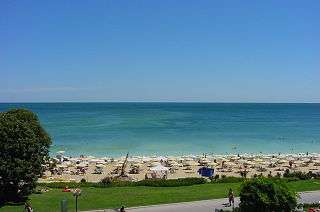
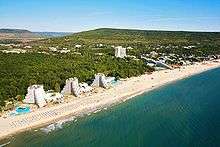
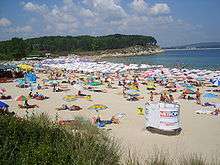
.svg.png)